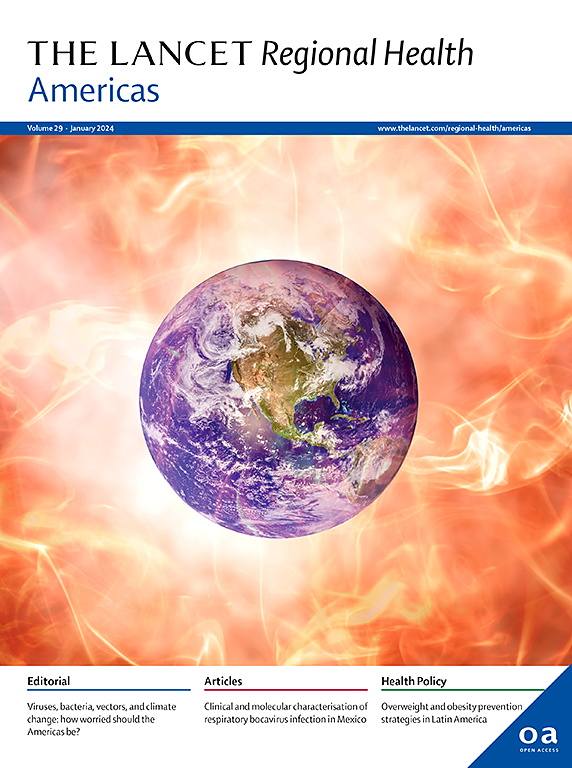儿童和青少年高血压相关的医疗资源利用和成本:一项基于人群的队列研究
IF 7
Q1 HEALTH CARE SCIENCES & SERVICES
引用次数: 0
摘要
背景:全球儿童高血压患病率增加,导致长期心血管和肾脏疾病。然而,儿童高血压的医疗资源利用和费用仍然不确定。本研究评估了高血压儿童与对照组相比的医疗保健利用和费用。方法在一项基于人群的回顾性队列研究中,我们分析了加拿大安大略省(1993-2021)诊断为高血压的青年(3-18岁)。使用倾向评分匹配,25,605名高血压儿童与128,025名对照进行比较,并随访至死亡、移民或2022年3月31日。通过负二项回归评估医疗保健利用(住院、急诊、门诊)。次要结局包括医疗费用和专家随访。结果中位年龄为15岁[IQR 11-17], 49%为女性,合并症少见(4%(6497/ 153630)先天性心脏病,2%(9359/ 153630)恶性肿瘤,2%(2892/ 153630)糖尿病,1%(2004/ 153630)慢性肾病)。在中位随访12.9年[IQR为6.8-19.9]年期间,高血压儿童的住院率(比率比[RR] 2.13, 95% CI 2.03-2.22)、急诊就诊率(RR 1.08, 95% CI 1.05-1.11)和门诊就诊率(RR 1.33, 95% CI 1.31-1.34)较高。高血压儿童的平均医疗费用要高得多,特别是在第一年(16,690美元对每人年2659美元)。青少年高血压患者的医疗资源利用率明显较高。这些发现为今后预防小儿高血压及其并发症的成本效益研究提供了基础。本研究部分由麦克马斯特大学儿科部门2021/2022年核心建设者团队资助,并由安大略省卫生部(MOH)和长期护理部资助的ICES Western支持。本文章由计算机程序翻译,如有差异,请以英文原文为准。
Healthcare resource utilisation and costs associated with hypertension in children and adolescents: a population-based cohort study
Background
The global prevalence of paediatric hypertension has increased, contributing to long-term cardiovascular and kidney morbidity. However, healthcare resource utilisation and costs attributable to paediatric hypertension remain uncertain. This study evaluates healthcare utilisation and costs among hypertensive children compared to controls.
Methods
In a population-based retrospective cohort study, we analysed youth (aged 3–18 years) diagnosed with hypertension in Ontario, Canada (1993–2021). Using propensity score matching, 25,605 hypertensive children were compared to 128,025 controls and followed until death, emigration, or 31 March 2022. Healthcare utilisation (hospitalisations, emergency visits, outpatient visits) was assessed via negative binomial regression. Secondary outcomes included healthcare costs and specialist follow-up.
Findings
Median age was 15 years [IQR 11–17], 49% were female, and comorbidities were uncommon (4% (6497/153,630) congenital heart disease, 2% (9359/153,630) malignancy, 2% (2892/153,630) diabetes, 1% (2004/153,630) chronic kidney disease). Over a median follow-up of 12.9 [IQR 6.8–19.9] years, hypertensive children had higher hospitalisations (rate ratio [RR] 2.13, 95% CI 2.03–2.22), emergency visits (RR 1.08, 95% CI 1.05–1.11), and outpatient visits (RR 1.33, 95% CI 1.31–1.34). Mean healthcare costs were substantially higher in children with hypertension, especially in the first year ($16,690 vs $2659 per person-year).
Interpretation
Healthcare resource utilisation was significantly higher in youth with hypertension. These findings provide a basis for future cost-effectiveness studies on preventing paediatric hypertension and its complications.
Funding
This study was funded in part by a 2021/2022 CoRE Builder Team Grant from McMaster University’s Department of Paediatrics and supported by ICES Western, funded by the Ontario Ministry of Health (MOH) and Ministry of Long-Term Care.
求助全文
通过发布文献求助,成功后即可免费获取论文全文。
去求助
来源期刊

Lancet Regional Health-Americas
Multiple-
CiteScore
8.00
自引率
0.00%
发文量
0
期刊介绍:
The Lancet Regional Health – Americas, an open-access journal, contributes to The Lancet's global initiative by focusing on health-care quality and access in the Americas. It aims to advance clinical practice and health policy in the region, promoting better health outcomes. The journal publishes high-quality original research advocating change or shedding light on clinical practice and health policy. It welcomes submissions on various regional health topics, including infectious diseases, non-communicable diseases, child and adolescent health, maternal and reproductive health, emergency care, health policy, and health equity.
 求助内容:
求助内容: 应助结果提醒方式:
应助结果提醒方式:


